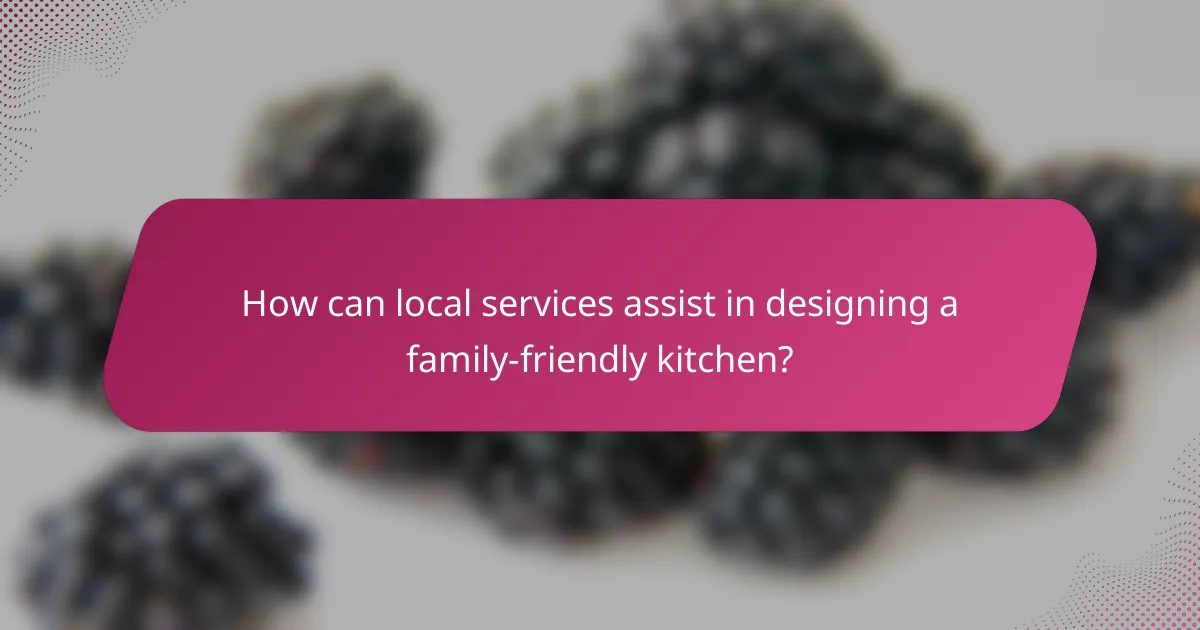A family-friendly kitchen prioritizes safety and accessibility, making it a welcoming space for all members of the household. Essential features such as childproof locks, non-slip flooring, and rounded countertop edges help minimize accidents, while a thoughtful layout promotes clear pathways and designated cooking areas. Incorporating accessibility elements like lowered countertops and easy-to-reach appliances ensures that everyone, including children and those with mobility challenges, can safely enjoy the kitchen environment.

What are the essential safety features for a family-friendly kitchen?
Essential safety features for a family-friendly kitchen include childproof locks, non-slip flooring, rounded countertop edges, accessible fire extinguishers, and strategically placed appliances. These elements work together to create a safer environment for children and reduce the risk of accidents.
Childproof cabinet locks
Childproof cabinet locks are crucial for preventing children from accessing hazardous items such as cleaning supplies and sharp utensils. These locks can be installed on cabinets and drawers, ensuring that little hands cannot easily open them.
When selecting locks, consider options that are easy for adults to operate but challenging for children. Magnetic locks and sliding locks are popular choices that provide effective security without compromising adult access.
Non-slip flooring
Non-slip flooring is essential in a family-friendly kitchen to minimize the risk of slips and falls, especially in areas prone to spills. Materials like textured vinyl, rubber, or treated wood can provide better traction compared to smooth surfaces.
When choosing flooring, look for options with a high coefficient of friction. Additionally, ensure that any rugs or mats used are also non-slip to maintain safety throughout the kitchen.
Rounded countertop edges
Rounded countertop edges help prevent injuries from sharp corners, which can be particularly dangerous for young children. Opting for countertops with rounded or beveled edges can significantly reduce the risk of cuts and bruises.
In addition to safety, rounded edges can enhance the overall aesthetic of the kitchen. When renovating, consider materials like quartz or solid surface that can be easily shaped to include rounded edges.
Fire extinguisher accessibility
Having a fire extinguisher easily accessible in the kitchen is a critical safety feature. It should be placed within reach, ideally mounted on a wall or stored in a cabinet that is not too high for adults to access quickly.
Ensure that the extinguisher is rated for kitchen use (Class K for grease fires) and check it regularly for maintenance. Familiarize all family members with its location and operation to ensure a swift response in case of an emergency.
Safe appliance placement
Safe appliance placement is vital to prevent accidents and ensure efficient kitchen use. Appliances should be positioned away from the edges of counters and out of reach of small children to minimize the risk of tipping or pulling them down.
Consider using appliance garages or cabinets to store items like blenders and toasters when not in use. This not only keeps them out of reach but also helps maintain a clutter-free workspace, reducing the chances of accidents.

How can kitchen layout enhance family safety?
A well-planned kitchen layout significantly enhances family safety by reducing hazards and improving accessibility. Key design elements like open spaces, clear pathways, and designated areas for cooking can help prevent accidents and ensure a safer environment for children and adults alike.
Open floor plan advantages
An open floor plan promotes visibility and interaction among family members, which can enhance safety. With fewer walls and barriers, parents can easily supervise children while cooking or preparing meals. This layout also allows for better airflow and natural light, creating a more inviting and safer space.
Consider integrating an island or a breakfast bar in an open kitchen to provide additional workspace while maintaining sight lines. This encourages family gatherings and keeps children engaged in the cooking process under supervision.
Clear pathways for movement
Clear pathways are essential for safe kitchen navigation, especially in a busy household. Ensure that there is ample space—ideally at least 1 meter—between counters, appliances, and furniture to allow for easy movement. This reduces the risk of tripping or bumping into objects.
Regularly declutter countertops and keep frequently used items within easy reach to minimize the need for stretching or reaching over hot surfaces. Consider using storage solutions that keep items organized and accessible without obstructing pathways.
Designated cooking zones
Creating designated cooking zones helps streamline meal preparation and enhances safety by keeping cooking activities contained. Allocate specific areas for food prep, cooking, and cleaning to minimize cross-contamination and accidents.
Use color-coded cutting boards and utensils to distinguish between raw and cooked foods in these zones. This practice not only promotes hygiene but also reinforces safety by reducing the likelihood of foodborne illnesses.
Separation of cooking and play areas
Separating cooking and play areas is crucial for maintaining a safe environment for children. Designate a specific area away from the kitchen for play, ensuring that it is easily visible from the cooking zone. This allows parents to supervise while keeping children safe from hot surfaces and sharp objects.
Consider using safety gates or barriers to physically separate these spaces, especially if the kitchen is small. Additionally, incorporate child-friendly furniture and activities in the play area to keep children engaged and away from kitchen hazards.

What accessibility features should be included in a family-friendly kitchen?
A family-friendly kitchen should incorporate accessibility features that cater to all family members, including children and individuals with mobility challenges. Key elements include lowered countertops, pull-out shelves, accessible storage solutions, and easy-to-reach appliances to enhance usability and safety.
Lowered countertops
Lowered countertops are essential for a family-friendly kitchen, as they allow children and individuals in wheelchairs to comfortably reach food preparation areas. Typically, countertops should be set at a height of around 28 to 34 inches, depending on the needs of the users.
When designing lowered countertops, consider integrating a mix of heights to accommodate various tasks, such as cooking and baking. Ensure that the surface is sturdy enough to withstand regular use while being easy to clean.
Pull-out shelves
Pull-out shelves enhance accessibility by allowing users to easily access items stored in deep cabinets without straining. These shelves can be installed in base cabinets or pantry areas, making it simpler for everyone to reach cooking essentials.
When selecting pull-out shelves, choose options with smooth glides and sturdy materials. Consider adjustable shelving heights to accommodate different items, from pots and pans to pantry goods, maximizing space efficiency.
Accessible storage solutions
Accessible storage solutions are crucial for keeping a family-friendly kitchen organized and functional. This includes using drawers instead of traditional cabinets, as drawers can be easier to open and see contents at a glance.
Incorporating clear bins or labels can further enhance accessibility, helping family members quickly find what they need. Consider using pull-down racks or lazy Susans for corner cabinets, ensuring that every inch of space is utilized effectively.
Easy-to-reach appliances
Easy-to-reach appliances are vital for a family-friendly kitchen, ensuring that everyone can safely use them. Position frequently used appliances, such as microwaves and toasters, at counter height to prevent accidents.
When choosing appliances, look for models with user-friendly controls and features such as automatic shut-off. Additionally, consider the placement of larger appliances like ovens and dishwashers to ensure they are accessible without requiring excessive bending or stretching.

What are the best materials for a family-friendly kitchen?
The best materials for a family-friendly kitchen prioritize safety, durability, and ease of maintenance. Choosing the right surfaces can significantly enhance the kitchen’s functionality while ensuring a safe environment for children and family activities.
Durable surfaces
Durable surfaces are essential in a family-friendly kitchen as they withstand daily wear and tear. Materials like quartz, granite, and solid surface countertops are excellent choices due to their resistance to scratches, heat, and stains.
When selecting durable surfaces, consider options that can handle spills and heavy use without showing damage. For instance, quartz offers a non-porous surface that doesn’t harbor bacteria, making it a practical choice for families.
Easy-to-clean finishes
Easy-to-clean finishes are crucial for maintaining hygiene in a family kitchen. Look for materials that resist staining and can be wiped down quickly, such as stainless steel appliances and ceramic tiles.
Incorporating finishes that are smooth and non-porous can minimize the time spent on cleaning. For example, using a backsplash made of glass or glazed tiles can help prevent grime buildup and make routine cleaning simpler.
Non-toxic materials
Non-toxic materials are vital for ensuring a safe cooking environment, especially for families with young children. Opt for finishes and products that are free from harmful chemicals, such as low-VOC paints and finishes.
When choosing cabinetry or countertops, look for certifications like Greenguard or FSC (Forest Stewardship Council) to ensure the materials meet safety standards. This not only protects your family’s health but also contributes to a more sustainable kitchen environment.

How can local services assist in designing a family-friendly kitchen?
Local services can provide valuable expertise in creating a family-friendly kitchen by offering tailored design solutions that prioritize safety, accessibility, and functionality. Engaging with professionals can help ensure that the kitchen layout meets the specific needs of families, making it a more enjoyable space for everyone.
Custom design consultations
Custom design consultations allow families to work with experts who understand the unique requirements of a family-friendly kitchen. These professionals can assess the space and recommend features that enhance safety and accessibility, such as rounded countertops, slip-resistant flooring, and child-proof cabinets.
During a consultation, consider discussing your family’s specific needs, such as the ages of children or any mobility challenges. This information helps designers create a layout that promotes ease of use and minimizes hazards, ensuring a safe environment for all family members.
When selecting a local service for consultation, look for those with experience in family-oriented designs. Check reviews and ask for examples of past projects to ensure they align with your vision for a functional and safe kitchen.


